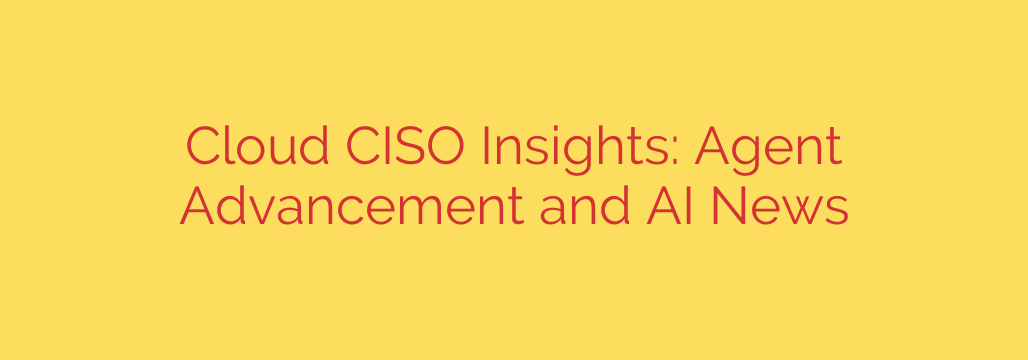
Navigating the New Frontier: The Dual Role of AI in Modern Cybersecurity
The rapid evolution of artificial intelligence is no longer a future concept—it’s a present-day reality transforming industries, and cybersecurity is at the very epicenter of this change. As AI capabilities grow, we are faced with a crucial duality: AI as an indispensable tool for defense and AI as a formidable new attack vector. For security leaders and organizations, understanding this dual nature is the first step toward building a resilient security posture for the future.
Recent global conversations, including historic summits on AI safety, underscore a worldwide consensus: the immense potential of AI must be balanced with a clear-eyed view of its risks. From generating sophisticated disinformation to enabling more advanced cyberattacks, the misuse of AI by malicious actors is a significant threat. This new landscape demands a proactive, security-first approach to both harnessing AI’s power and defending against its misuse.
The Rise of Autonomous AI Agents
One of the most significant advancements in this field is the development of autonomous AI agents. Think of these not as simple chatbots, but as sophisticated systems capable of pursuing complex goals with minimal human intervention.
An AI agent functions much like a human project manager or travel agent. You provide it with a high-level objective—for example, “Plan a business trip to Tokyo for next week”—and the agent independently breaks down the goal into smaller tasks. It can then research flights, compare hotel prices, check schedules, and even make bookings, executing the entire plan from start to finish.
In the context of technology and business, these agents can write code, manage complex cloud infrastructure, and automate intricate workflows. While this promises unprecedented efficiency, it also introduces new security challenges that we must address head-on.
AI as a Force Multiplier for Security Teams
On the defensive side, AI is proving to be a game-changing asset for security operations (SecOps). Human security analysts are brilliant, but they are also finite. They face an overwhelming flood of data, alerts, and potential threats. This is where AI excels.
By leveraging AI, we can dramatically scale threat intelligence and analysis. For instance, AI models can be trained to:
- Analyze malware at machine speed, reverse-engineering code to identify its function, origin, and potential impact in seconds rather than hours.
- Sift through petabytes of threat data to identify patterns, TTPs (tactics, techniques, and procedures), and emerging threat campaigns that would be invisible to the human eye.
- Automate incident response, allowing security teams to focus their expertise on the most critical and complex threats.
Essentially, AI acts as a powerful force multiplier, augmenting the capabilities of human experts and allowing organizations to build a more proactive and intelligent defense system.
The Other Side of the Coin: Securing AI Itself
While we integrate AI into our security stack, we cannot forget that AI systems themselves are a new and attractive attack surface. If an AI model is compromised, it can be manipulated to produce false information, ignore real threats, or leak the sensitive data it was trained on.
Therefore, securing the AI is just as critical as using AI for security. This requires a fundamental shift toward a Secure AI Development Lifecycle. We must apply the same rigor to building AI models that we apply to developing critical software. This includes:
- Securing the data supply chain to ensure training data is clean and not poisoned by attackers.
- Hardening the models themselves against adversarial attacks designed to fool or manipulate them.
- Implementing robust access controls and monitoring for the infrastructure that hosts and serves the AI models.
A key practice emerging in this space is AI Red Teaming. Similar to traditional penetration testing, AI Red Teaming involves intentionally “attacking” your own AI models to discover vulnerabilities before malicious actors do. By stress-testing models for flaws, biases, and security gaps, organizations can build more resilient and trustworthy AI systems.
Actionable Steps for a Secure AI Future
Navigating this new era requires deliberate action. Organizations should prioritize the following steps to harness AI’s benefits while mitigating its risks:
- Invest in AI for Your SecOps: Start integrating AI-powered tools to automate threat detection, analyze malware, and empower your security analysts. Focus on solutions that augment human expertise, not just replace it.
- Establish a Secure AI Lifecycle: If your organization is developing or deploying AI models, treat them as critical assets. Implement security controls throughout the entire lifecycle, from data sourcing and training to deployment and monitoring.
- Create an AI Red Team: Proactively test your AI systems for vulnerabilities. This can be an internal team or a third-party service dedicated to finding and fixing security flaws in your models before they can be exploited.
- Promote Collaboration and Education: The challenges of AI security are too large for any single organization to solve. Foster a culture of learning and collaborate with industry peers, researchers, and government bodies to stay ahead of emerging threats and best practices.
The age of AI is here, and it is reshaping the battlefield of cybersecurity. By embracing AI as a defensive tool while diligently securing the technology itself, we can navigate this new frontier with confidence and build a safer digital future.
Source: https://cloud.google.com/blog/products/identity-security/cloud-ciso-perspectives-our-big-sleep-agent-makes-big-leap/








